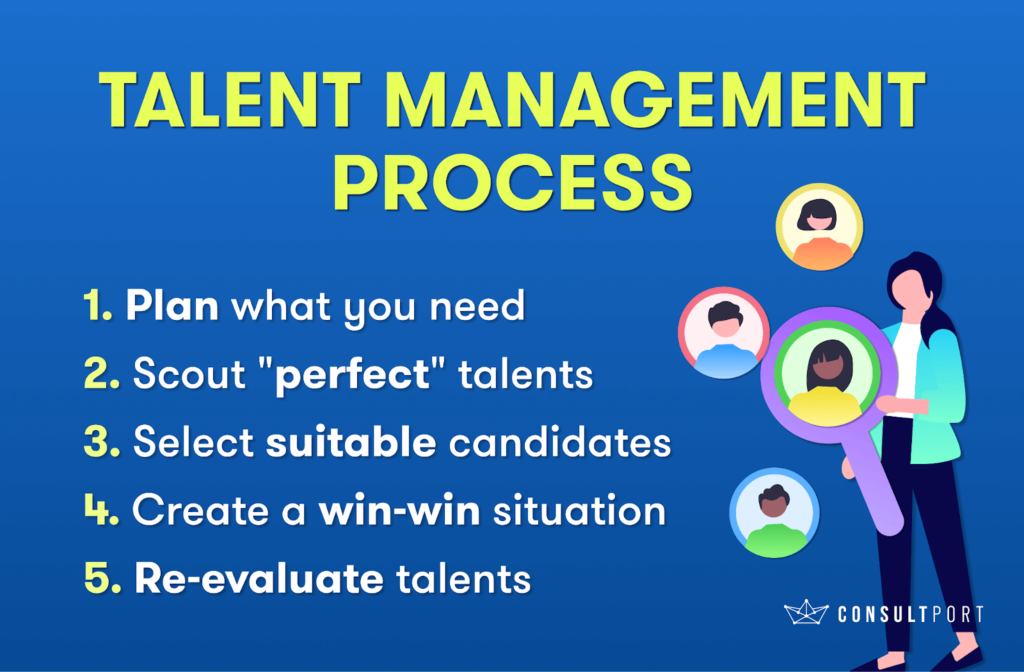How To Make The Most Of Talent On Demand?
Blog Categories:
Published:
May 8, 2023
Reading Time:
8 minutes

After the pandemic, almost every business faced a critical question: Can and should employees return to work as before? The root of this idea lies in the rise of talents on demand, a trend that began long before Covid-19 yet has truly blossomed thanks to remote working and social distancing. It has been three years since the outbreak, and many companies' owners are now confident to say freelancers are the future of human resources management.
This article will help you explore the phenomenon of talent on demand, how they alter the course of a business, and how you can take advantage of these freelancers.
This article will help you explore the phenomenon of talent on demand, how they alter the course of a business, and how you can take advantage of these freelancers.
I. What is talent on demand?
As the name suggests, talents on demand are freelancers, independent contractors, gig workers, and consultants recruited at needed times for specific projects.
Unlike full-time employees, these workers only stay until projects are complete or when there's no more "demand" for their services. Usually, they work remotely or only spend a short time in the office. The gigs vary widely from driving and delivering food to designing websites or writing articles; even some jobs are at high levels as managers, lawyers, or consultants.
Four notable trends are occurring in the on-demand labor market:
Unlike full-time employees, these workers only stay until projects are complete or when there's no more "demand" for their services. Usually, they work remotely or only spend a short time in the office. The gigs vary widely from driving and delivering food to designing websites or writing articles; even some jobs are at high levels as managers, lawyers, or consultants.
Four notable trends are occurring in the on-demand labor market:
- Globally and remotely: This new motto results from employees wanting more independence in their working environment, especially after experiencing remote working effectiveness in quarantine. For instance, Zoom makes it a blink of an eye to contact customers between continents.
- AI and automation tools: The rise of supporting technology lets businesses cut down on traditional resources and require fewer humans to run a project.
- Diversity, equity, and inclusion: The DEI discipline welcomes everyone from different backgrounds to join the tasks, allowing freelancers to sell their abilities to those in need.
- The value of experience: Recruiters and job seekers appreciate expertise-based and soft skills more than ever. Mutual goals lie in final achievements.
KEY TAKEAWAYS
- Talent on demand, or on-demand recruiting, is hiring freelancers for a specific period. They are not your full-time employees.
II. Why do companies shift to temporary employee recruitment?
You cannot deny that temporary workers cannot replace your long-term and full-time employees. Yet, freelancers are believed to be the key to businesses' rapid development, especially in the SME sector. Below are the four biggest reasons supporting this view.
1. The cure for human resources shortage
Modern companies are taking on more projects to increase their profits. Unlike traditional operations, when brands concentrated only on a few aspects, now they tend to deploy as many tasks as possible.
For example, a restaurant can sell everyday foods and beverages as well as join a catering service. In addition, they can create self-designed merchandise for more effective branding. Agencies work on their own projects and, at the same time, take on work requests from other companies via outsourcing.
READ MORE | 90% of small businesses are struggling with human resources
This trend puts tons of pressure on staff, leading to burnout and lower productivity. Moreover, not all businesses can guarantee that the quality and quantity of their employees can support the project's success. C-level managers consider human resources shortages the most significant threat to their development strategy. Here's when freelancers step in to share the workloads. With the help of skillful individuals, the whole process, from management to execution, is efficient and focused.
"A gig economy is a labor market that relies heavily on temporary and part-time positions filled by independent contractors and freelancers rather than full-time permanent employees."
In short, this is the dreamland for talent on demand.
It is also aided by the pandemic, which changed global workers' working behaviors, as 80% of employees prefer freelancing over staying in the office. With support from platforms like Fiverr or Upwork, employers can easily find suitable candidates worldwide for specific projects. For example, even though you are a European business, having a half-time team working on your Thailand project is not impossible.
Research from Upwork emphasizes the importance of specialization thanks to hiring freelancers, as the job can be accomplished 50% faster than traditional approaches. 53% of gig workers can provide services usually lacking in businesses, such as IT, marketing, computer programming, and business consulting. 90% of CTOs believe that without IT freelancers' help, they would have to delay, cancel or extend a project.
For example, a restaurant can sell everyday foods and beverages as well as join a catering service. In addition, they can create self-designed merchandise for more effective branding. Agencies work on their own projects and, at the same time, take on work requests from other companies via outsourcing.
READ MORE | 90% of small businesses are struggling with human resources

This trend puts tons of pressure on staff, leading to burnout and lower productivity. Moreover, not all businesses can guarantee that the quality and quantity of their employees can support the project's success. C-level managers consider human resources shortages the most significant threat to their development strategy. Here's when freelancers step in to share the workloads. With the help of skillful individuals, the whole process, from management to execution, is efficient and focused.
2. The rise of the gig economy and the international workforce
Technology growth has led to the beginning of the gig economy in the past couple of years. According to Investopedia,"A gig economy is a labor market that relies heavily on temporary and part-time positions filled by independent contractors and freelancers rather than full-time permanent employees."
In short, this is the dreamland for talent on demand.

It is also aided by the pandemic, which changed global workers' working behaviors, as 80% of employees prefer freelancing over staying in the office. With support from platforms like Fiverr or Upwork, employers can easily find suitable candidates worldwide for specific projects. For example, even though you are a European business, having a half-time team working on your Thailand project is not impossible.
3. A flexible way to specialize in multiple projects
Approximately 1.57 billion people in the global workforce are freelancers, and over half have postgraduate education. So rather than filling in the blanks with inexperienced employees, businesses now have the chance to find the perfect candidate in the gig labor market. Furthermore, hiring these talents will reduce staff training time since part-timers are already skilled and have been working in the needed fields.Research from Upwork emphasizes the importance of specialization thanks to hiring freelancers, as the job can be accomplished 50% faster than traditional approaches. 53% of gig workers can provide services usually lacking in businesses, such as IT, marketing, computer programming, and business consulting. 90% of CTOs believe that without IT freelancers' help, they would have to delay, cancel or extend a project.
4. Money, money, money
Instead of weighing your business down with full-time incompetent workers, you can reduce overhead costs with on-demand recruiting. A part-time worker can cut down $11,000 for a company annually. A company can save up to $17,000 when hiring a senior software developer compared to a permanent worker. Companies can invest these savings in building a hybrid and flexible working environment and winning more profitable deals.III. 5 best practices for managing the talent on demand
Within the next two years, 60% of business owners plan to utilize more independent workers. However, managers can struggle to control and ensure contractors' work quality, as it is still a massive challenge for close supervision. We're here to help you solve this headache problem with five simple-yet-useful steps to manage your talents effectively.1. Create clear missions and visions for the jobs
If you are considering hiring temporary workers soon, first create a quick introduction about your company and the project they will join. Since freelancers are not permanent members of your business, they need help to know your style and purpose. Also, creating a clear image of your brand will build trust with remote workers. The digital world is a two-edged sword, thus people need help distinguishing between reliable and scam agencies as well as employees.Furthermore, freelancers must understand the project's goal. It would be a disaster if they sent you something incompatible with the job. You still have to pay since they have done their part, yet the finished product cannot contribute to the project. It is recommended to have at least one face-to-face meeting or direct call before starting the job; so all parties are well aware of the targets and related requirements.
2. Have a transparent job description (JD) and working process
Besides giving a clear vision of who you are, having a thorough job description and working guidelines will help you find the most suitable candidates for the project. A detailed JD stating exactly what you require will simplify your time scouting the right talent.Here are some of the questions that need to be answered when potential workers read your JD:
- What are their tasks? Is this the full scope of work?
- How long would their service take?
- Are they working directly with you or others?
- What is the pay rate?
- Do you request any skill sets, tools, or certifications to work on the job?
- How do they work: Can they work remotely, or must they come to the office?
- Do you need references or information about their previous experiences?
3. Don't discriminate against your temporary workers
Some may worry that business owners struggle to treat temporary workers in the same way as regular full-time employees. This concern is based on the idea that freelancers hold much less responsibility than traditional staff since they can "run away" anytime.However, a lack of trust and respect will be the downfall of your projects, as both sides are always suspicious. Therefore, making your on-demand workers feel like they are a part of your business is crucial. You can see them as regular full-time workers with unusual working times and places.
4. Learn how to retain existing talents
While utilizing freelancers' services, several companies faced high bounce rates, as workers only stayed for a short time. As a result, the whole operation's productivity and the agencies' reputation are severely affected. Conversely, some firms are extremely satisfied with the work of particular freelancers and hope to renew their contracts.Regardless of the experience with on-demand workers, talent retention is urgent. Creating a win-win situation and regularly re-evaluating performance can show temporary workers your appreciation for their dedication and persuade them to continue. To some extent, retaining part-time consultants and administrative managers can make or break your projects.

5. Find reliable platforms for freelancers
Each of the four tips mentioned above relates to the company's processes and work ethic. Yet, there's one thing we still need to cover: How to find these talents?Hundreds of options are available on the Internet daily. With the help of digital platforms, it has never been easier to sell freelance services than now. The question is whether you can find the diamond within the rocks. Freelancers' websites, such as Fiverr or Upwork, can be an easy starting point for any business. If you seek a niche service, agencies specializing in hunting and hiring temporary workers, like Consultport, can quickly help you solve the case.
Conclusion
Talent on demand is the new way businesses solve human resources problems (especially after the pandemic), as they find a flexible method to utilize the freelance workforce. Convenience, however, comes with its own challenges.
It's essential to approach the gig economy with care and attention to detail. If hiring talent on demand isn't done correctly, it can quickly turn chaotic and leave you feeling like you're managing a group of headless chickens. So take your time to understand how to recruit and manage these freelancers effectively. Trust me; it's worth the extra effort in the long run.
If you still find it difficult, Consultport is ready to help! We are a team of hundreds of talents worldwide committed to supporting your brands to reach new levels. Covering multiple fields, from Digital Readiness Assessment to Business Model Digitization, we will bring the necessary force to upgrade your human management strategies.
Contact us now for more information.
It's essential to approach the gig economy with care and attention to detail. If hiring talent on demand isn't done correctly, it can quickly turn chaotic and leave you feeling like you're managing a group of headless chickens. So take your time to understand how to recruit and manage these freelancers effectively. Trust me; it's worth the extra effort in the long run.
If you still find it difficult, Consultport is ready to help! We are a team of hundreds of talents worldwide committed to supporting your brands to reach new levels. Covering multiple fields, from Digital Readiness Assessment to Business Model Digitization, we will bring the necessary force to upgrade your human management strategies.
Contact us now for more information.
Share This Story, Choose Your Platform!



